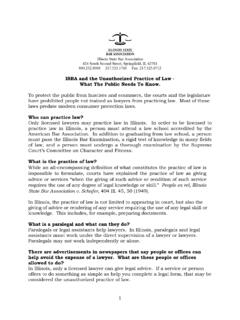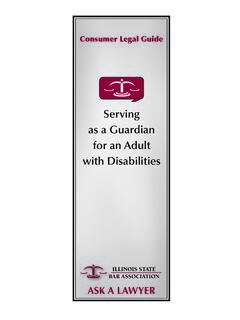Transcription of CHAPTER 6: CRIMINAL PROCEDURE - Illinois State Bar …
1 CHAPTER SIX: CRIMINAL PROCEDURE By Gino L. DiVito, Retired Justice, Illinois Appellate Court, Partner, Quinlan & Crisham, Ltd.; Chicago Commencement of Prosecution In Illinois , the prosecution of a CRIMINAL offense begins with the filing of a complaint, an information or an indictment. All three are written statements or charges ( charge is the generic term that encompasses a complaint, an information, and an indictment) that are presented to a court and charge the commission of an offense. In all cases, the charge must State the name of the accused, the date of the offense, the county or venue in which the offense was committed, the name of the offense and the statutory provision alleged to have been violated and the elements of the offense charged.
2 A complaint is signed under oath usually by a police officer, complaining witness or other person having knowledge of the CRIMINAL act alleged. A complaint frequently initiates a felony charge; it generally is the charging document filed in the preliminary hearing court but, as indicated below, either an information or an indictment must be filed for a felony trial to occur. A complaint alone, however, is sufficient to bring the prosecution of all petty offenses and misdemeanors. In such cases, a court may proceed to trial based solely upon a complaint without any further determination of probable cause.
3 A traffic citation issued by a peace officer serves the same function as a formal complaint in charging violations of the Illinois Vehicle Code. When the charge is a felony, a waiver of preliminary hearing by an accused person, a finding of probable cause by a judge or a grand jury indictment is necessary before a court can proceed to a trial on the charge. In Illinois , prosecution of a felony may be by information or by indictment. An information is a verified legal document containing the charge signed by the State s attorney.
4 The State s attorney may file it after a waiver of preliminary hearing by an accused or after a finding of probable cause by a judge. An indictment is the charge brought by the grand jury, which can initiate proceedings against an accused, consider evidence before or after a judge s finding of probable cause, or bring a charge despite a finding of no probable cause by a judge. In Illinois , except for delay caused by a defendant or for specific other reasons such as a fitness examination for a defendant, preliminary hearing or indictment must occur within 30 days for an incarcerated defendant or within 60 days for a defendant on bond.
5 A peace officer may arrest a person without a warrant if he has reasonable grounds to believe that the person is committing or has committed an offense. In most CRIMINAL cases, the defendant is already in custody when the complaint is filed. If the defendant has not been taken into custody, he may be brought to answer the charge by issuance of a summons, a notice to appear or an arrest warrant. A summons is issued by a court and signed by a judge. A notice to appear may be issued by any peace officer or the State s attorney.
6 Such documents set forth the name of the accused and the alleged offense along with a request for the accused to appear before a court at a certain time and place. Although the State s attorney may seek an arrest warrant at any time, a summons or a notice to appear may be employed in less serious cases to avoid the necessity of a formal arrest. If the accused fails to appear after such notification or if circumstances warrant, a judge may issue an arrest warrant for the accused. Before the initial issuance of an arrest warrant, the judge makes a preliminary finding that the person against whom the complaint is made has committed an -{PAGE }- offense.
7 This is accomplished through a review of the sworn complaint that accompanies the arrest warrant and an examination of the complainant and/or other witness. After issuing the arrest warrant, the judge endorses upon it the amount of money required to be posted as bail to secure the release of the accused. The Initial Appearance Upon a defendant s arrest or voluntary appearance in answer to a charge, he must be taken before a judge without unnecessary delay. The judge then informs him of the charge against him and provides him a copy of the charge.
8 The defendant is advised of his right to be represented by counsel and, if he is indigent, a lawyer is appointed to represent him. The judge then fixes bail in a reasonable amount necessary to ensure the defendant s further appearance as required. In a felony case, a defendant usually does not plead at the initial appearance. If the charge is a misdemeanor, the defendant may plead, thus combining the initial appearance and the arraignment. If the defendant pleads not guilty to a misdemeanor at the initial appearance, the case can be set for trial.
9 Where the charge is a felony, the arraignment will be held after the grand jury indictment or the filing of an information. Bail Bail is the process by which a defendant is released from custody upon the pledge of -{PAGE }- a security to guarantee his appearance in court. A bond (or bail bond) is the amount of money required to be posted or the security signed by the defendant to secure his appearance. A judge must set the amount of bond. This will be done at the initial appearance and it probably will be considered again at the arraignment, but it may be raised or lowered at any time upon a showing of good cause.
10 When a defendant is arrested on an arrest warrant, the judge issuing the warrant will have endorsed the amount of the bond on the warrant. This amount will remain as the required bond unless a different judicial determination is made at the initial appearance or at any time thereafter. The amount of bail must not be oppressive but must be sufficient to assure compliance with its conditions. It must be commensurate with the nature of the offense charged while taking into account the past CRIMINAL acts of the defendant and his financial ability.









